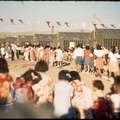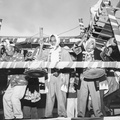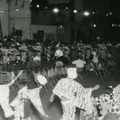Manzanar
The Obon festival at the Manzanar concentration camp in 1943 opened with an interfaith dedication of the Ireito (Consoling-Spirits-Tower), a concrete obelisk memorializing those who passed away in camp. Bon odori was held on August 14 and 15 at the large firebreak next to the high school and featured a yagura, spotlights, and a large taiko. Recalling similar scenes at the Nisei Week Festival in Los Angeles, the reporter for the Manzanar Free Press estimated 1,500 dancers of all ages including staff teacher Eve Beekman, well-dressed boys from block 15, and girls in kimono, drolly observing, “As girls swished by the smell of mothballs lingered behind.” That same summer, an Obon Dance was sponsored by the San Pedro Yogores club to purchase baseball equipment, and Bon odori was presented at the camp hospital by 200 dancers for patients who couldn’t attend the Obon.1
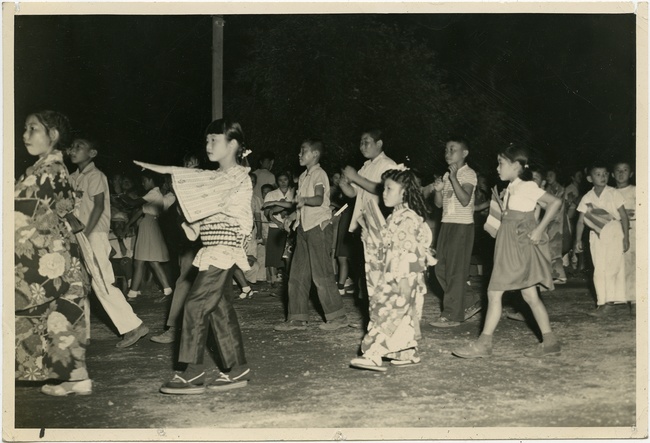
Minidoka
At the Minidoka concentration camp, a volunteer committee from sections 5 and 6 organized an outdoor revue in July 1943 with the Norakuro Harmonica Band, three Japanese classical dance schools, and Bon odori featuring a new version of “Minidoka Ondo” (unfortunately lost). Later in the summer, a camp-wide Bon odori committee presented a “Gigantic Bon Odori Festival” on the weekend of August 21 and 22. Following numerous dance practices, Bon odori was held at the ball field between blocks 32 and 34 on Saturday and the block 12 field on Sunday with approximately 1,000 participants each evening.
The reporter for The Minidoka Irrigator reminisced, “Many a Seattleite hearing the familiar odori music probably recalled—6th and Main, the incline in front of the old Nichiren church, Lincoln Park, Jefferson Park . . . and the endless succession of ice cream, pop and watermelon downed at such occasions.”2
Poston
The Poston concentration camp consisted of three distinct camps separated by desert and farmland. Camp 1 opened in May 1942 and held Poston’s first Obon on August 22 and 23. Sponsored by the Young Buddhist Association, the Obon was a gala affair with memorial services, Bon odori, plentiful refreshments, and a bazaar with geta, wooden toys, lapel pins, necklaces, paper flowers, and other homemade items for sale. On both evenings, over 700 participants danced to “Kagoshima Ohara Bushi,” “Rafu Ondo,” and “Sakka Bushi,” with the addition of “America Ondo” on Sunday. Camp 3 organized its own Obon in late September with lighting, a stage, and Bon odori led by Koraku Yamane. While details are scant, a humorous Bon odori called “Poston Bushi” or “Poston Ondo” (unfortunately lost) was created by Katsumi “Kats” Manaka of Camp 3 and performed at camp talent shows in the fall of 1942.3
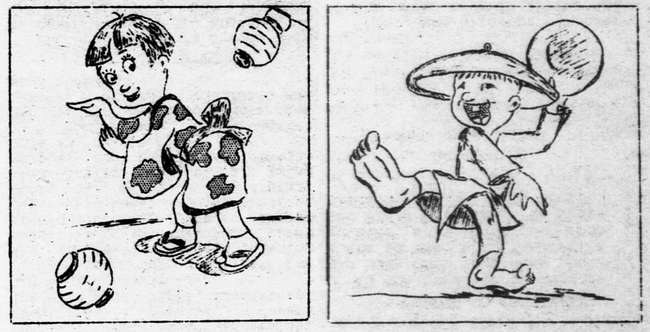
Rohwer
In the summer of 1943, Bon odori was featured in the Rohwer concentration camp at the Fourth of July Jamboree and Obon. Dances for the jamboree were taught by Kasui Deguchi with assistance from Grace Hagio, Yukino Okubo, and LoRayne Sugimoto. Illuminated by the camp’s new spotlights, approximately 700 participants danced a number of Bon odori including “Nagoya Yoitoko,” “Sonna Okata ga Attanara,” and “Tennen no Bi” at the high school field.
On August 14 and 15, the camp’s first Obon was held with Bon odori on both evenings at the same location. Dances included “Hiroshima Ondo,” “Kagoshima Ohara Bushi,” “Nagoya Yoitoko,” “Shinsaku Bon Odori,” “Sonna Okata ga Attanara,” “Tairiku Bushi,” and “Tonari Gumi” with taiko accompaniment by Isamu “Sam” Sugimoto and a special performance of “Goshu Ondo” by singer Shokichi Morino and drummer George Hiki. According to The Rohwer Outpost, approximately 500 dancers and 3,500 spectators joined the festivities.4
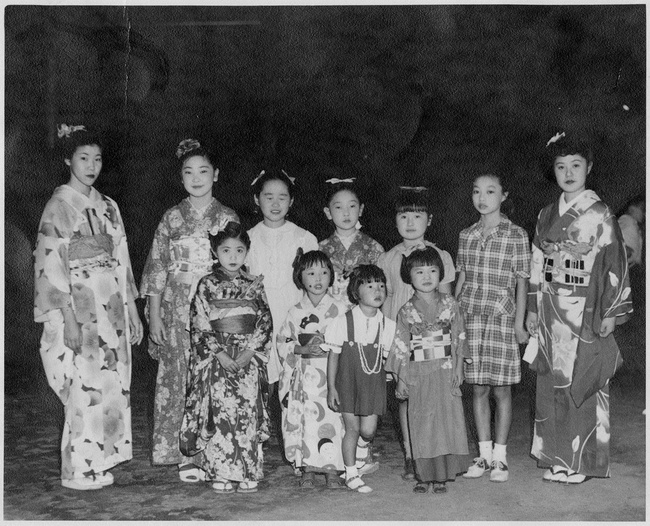
Topaz
The Topaz concentration camp opened in mid-September 1942 and held its first Obon on the weekend of August 14 and 15, 1943. Dance practices began in late July, led by Grace Fujimoto, Fumi and Masako Hanyu, Yasuko Ishida, June Nakayama, Masako Neishi, and Harue Yamamoto. Obon started on Saturday with an evening service and continued on Sunday with morning services and Bon odori in the evening interspersed with music and dance performances. Over 200 participants clasped their fans, flags, and kachi-kachi and danced “America Ondo,” “Gion Kouta,” “Hinomaru Okesa,” “Kagoshima Ohara Bushi,” “Kurogane Bushi,” “Mokyo Bushi,” “Nisei Koushinkyoku,” “Nisei Musume Koushinkyoku,” “Sakura Ondo,” “Shin Okesa,” and “Yasuki Bushi to Heitai” at the high school plaza in the center of the camp. Despite a huge dust storm in the early evening, Bon odori took place as scheduled, and an estimated 3,000 people participated in the Obon.5
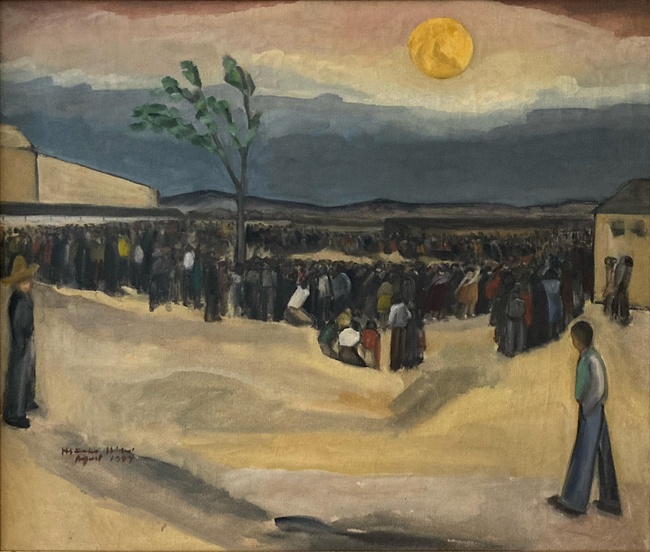
Tule Lake
At the Tule Lake concentration camp, the Fourth of July festival in 1943 stretched across three days and included food, sumo matches, softball and baseball games, talent shows, music performances, speeches, a youth dance, and Bon odori on Saturday evening led by professional dance teachers Misa Bando and Sahomi Tachibana and their students Lillian Fukunaga, Shizuko Inbe, Aiko and Mitsuko Suekawa, and Yuriko Lily Tsutsui. While details are limited, The Daily Tulean Dispatch tantalizingly reported, “Bon odori on Saturday evening proved to be quite hilarious as scores of boys danced the colorful ondo bedecked in weird costumes.” Two weeks later, the Buddhist Church and Young Buddhist Association organized a two-day Obon festival on July 17 and 18 with a program of cemetery visitations, memorial services, talent shows, a softball game, and Bon odori on both evenings at the outdoor stage on the northeast side of the camp.6
* * * * *
Notes
1. “Colorful Obon Festival Draws Capacity Crowd,” Manzanar Free Press, August 18, 1943; Noboru Myose, ed. Manzanar Bussei Guide (Manzanar, California: Manzanar Buddhist Church, 1943): 23; Duncan Ryuken Williams, American Sutra: A Story of Faith and Freedom in the Second World War (Cambridge, Massachusetts: Belknap Press of Harvard University Press, 2019): 139-144. See also Manzanar Free Press, Aug. 4, 1943, 3; Aug. 11, 1943, 1; Aug. 18, 1943, 1.
2. “Feminidoka,” The Minidoka Irrigator, August 28, 1943. See also The Minidoka Irrigator, July 31, 1943, 5; Aug. 14, 1943, 5; Aug. 21, 1943, 5; Aug. 28, 1943, 5.
3. “Poston Buddhist Temple in America,” BANC MSS 67/14 c, folder J2.979, pages 1-2. Japanese American Evacuation and Resettlement Records, The Bancroft Library, University of California, Berkeley. See also Official Daily Press Bulletin, Aug. 16, 1942, 1; Aug. 21, 1942, 1-2; Aug. 23, 1942, 1; Press Bulletin, Sept. 10, 1942, 6; Sept. 25, 1942, 6; Sept. 29, 1942, 3; Oct. 4, 1942, 6; The Reedley Exponent, Oct. 1, 1942, 6.
4. The Rohwer Outpost, June 30, 1943, 4; July 3, 1943, 1; July 17, 1943, 4; Aug. 7, 1943, 4; Aug. 11, 1943, 4; Aug. 14, 1943, 1, 5; Aug. 18, 1943, 4.
5. Topaz Times, July 17, 1943, 6; July 22, 1943, 4; Aug. 3, 1943, 2; Aug. 12, 1943, 4; Aug. 14, 1943, 3; Aug. 28, 1943, 7.
6. Eugene Okada, “Eugene Okada’s Our Town,” The Daily Tulean Dispatch, July 6, 1943. See also The Daily Tulean Dispatch, June 16, 1943, 5; June 19, 1943, 1; July 3, 1943, 3; July 16, 1943, 1; July 17, 1943, 2.
* * * * *
Bibliography
Akiyama, Linda Cummings. “Reverend Yoshio Iwanaga and the Early History of Doyo Buyo and Bon Odori in California.” Master’s thesis, University of California, Los Angeles, 1989.
Fong, Josh, director. Shirley Muramoto-Wong, creative director. Hidden Legacy: Japanese Traditional Performing Arts in the World War II Internment Camps. Oakland, CA: Murasaki Productions LLC, 2014. DVD.
Kiyama, Wynn. “Obon Dancing in America: Reverend Yoshio Iwanaga Photo Album.” Portland State University Library, Digital Exhibits, 2015. https://exhibits.library.pdx.edu/exhibits/show/obondancing/overview.html.
Myose, Noboru, ed. Manzanar Bussei Guide. Manzanar, California: Manzanar Buddhist Church, 1943.
“Poston Buddhist Temple in America.” Japanese American Evacuation and Resettlement Records, The Bancroft Library, University of California, Berkeley.
Soga, Yasutaro. Life behind Barbed Wire: The World War II Internment Memoirs of a Hawai‘i Issei. Translated by Kihei Hirai. Honolulu: University of Hawai‘i Press, 2008.
Spencer, Robert. “Religious Life in the Gila Community, November 2, 1942.” Japanese American Evacuation and Resettlement Records, The Bancroft Library, University of California, Berkeley.
Waseda, Minako. “Extraordinary Circumstances, Exceptional Practices: Music in Japanese American Concentration Camps.” Journal of Asian American Studies 8, no. 2 (2005): 171-209.
Williams, Duncan Ryuken. American Sutra: A Story of Faith and Freedom in the Second World War. Cambridge, Massachusetts: Belknap Press of Harvard University Press, 2019.
* * * * *
Thanks to Julie Yumi Hatta, Reiko Iwanaga, Traci Kiyama, Devynn Kochi, Shirley Muramoto-Wong, Brian Niiya, Alan Rosenfeld, and Kevin Yoza.
© 2024 Wynn Kiyama


